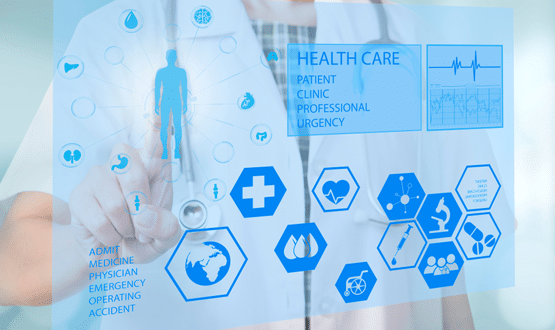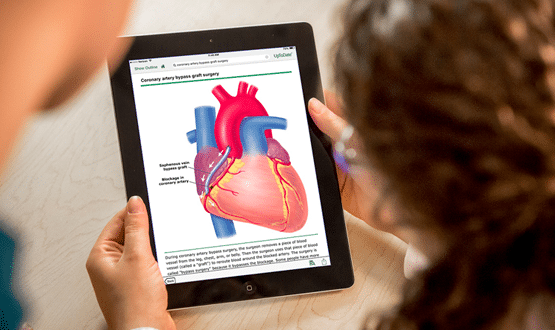Advisory Series: Patient Safety
- 28 March 2018

Patient Safety – Advisory Series, March 2018

By Claire Read – Digital Health
Many believe that technology has a crucial role to play in reducing avoidable harm and bolstering safety in the NHS. And while digital solutions are being designed to improve care, they will be properly effective only if they are efficient and reliably implemented. Claire Read reports.
About 15 years back, Suzette Woodward and her colleagues sat down to confront quite the complex challenge: how could the NHS build a system through which avoidable patient harm could be reported, analysed and, crucially, learnt from?
Woodward was patient safety director at the National Patient Safety Agency – the body then responsible for reducing avoidable harm across the NHS – and developing that system was one of its primary goals. And so, in 2003, the National Reporting and Learning System (NRLS) was born.
From ‘what’ to ‘why’
In that launch year alone, the system received one million electronic reports of avoidable harm. It’s a number which has remained consistent in the time since; a clear demonstration both of the scale of the issue, and that the ‘reporting’ part of the system is working.
But, over a decade on, Woodward – now campaign director at Sign Up to Safety – confesses much more doubt over whether the ‘learning’ part is.
“I think the decisions we made about the algorithm for how you would collect the information has led us to having reports now which say: ‘This is the number of falls we’ve had, this is the number of pressure ulcers we’ve had, this is the number of cases of sepsis’ But it tells us nothing about why they’e happening. So there’s a lot of what but very little of why.”
She continues: “If only we had been able to really, truly understand the importance of setting that up before you get to the software – so really thinking about the purpose of the thing that you’re designing.”
Role of digital
It’s a reflection which will chime with many of those exploring how digital might play a role in improving healthcare generally, and reducing avoidable harm more specifically. But it also underscores the role that digital can play in bolstering safety in the NHS. Understand the problem properly, design a digital solution around it, and the result just might be better patient care.
Some hospitals have reported that by, for instance, implementing electronic observations they have seen reductions in avoidable harm caused by unrecognised deterioration.
Many feel electronic tools might also help clinicians spot sepsis, a tricky-to-diagnose condition that can be deadly – in the UK, it claims more lives each year than prostate, breast and bowel cancer put together.
And e-prescribing has long been cited as a means of addressing the major patient safety issue that is medication error.
Indeed, Jeremy Hunt is sufficiently convinced of the virtues of electronic prescribing that he has announced a £75m investment in helping hospitals to implement such systems.
The Department of Health and Social Care suggested the result could be as much as a 50% reduction in medication errors.
A study carried out by the Universities of York, Manchester and Sheffield has estimated there are 237 million such errors occurring in the English NHS each year – that would be a significant reduction in the risk of patient harm.
Digital clinical decision support
For Manpreet Pujura, a practising GP and the clinical director for patient safety at NHS Digital, it is in the form of decision support that digital can play the biggest role in bolstering safety.
But he dreams of a setup whereby computer systems don’t just advise when – for instance – you’re about to prescribe a drug to which a patient is allergic, but which give a much greater degree of intelligence.
“The thing that can really make the difference is decision support at the time of the encounter – ‘live’ decision support. The IT is interacting with that patient’s record and potentially not only advising me of the possible diagnosis or investigations or examinations that I need to do, but also interacting with that patient’s historical record, and providing me with a better picture of how to treat them, or how to manage them.”
“That doesn’t happen at the moment,” he adds. “A clinician listens to all [a patient is saying about a concern], examines the patient, decides on investigations, might decide to prescribe something, and that is the only time where decision support will come in. That has to change if we’re going to avail ourselves of the huge benefits.”
Phil Jennings agrees that there is further to go when it comes to improving safety through digital clinical decision support.
“There’s a lot of data that we don’t really use to its full potential at the moment,” argues Jennings, a practising GP and the medical director for Innovation Agency. He leads on patient safety for the body, which is the academic health science network for the North West Coast.
“When I’m prescribing at the moment, the system will tell me about gross interactions of drug a and drug b, but it doesn’t really go beyond that. So although I might know that a patient might have, say, impaired kidney function, or impaired liver function, and that data is sitting inside my clinical system, it doesn’t make the link between that and giving me prescribing support.”
Sharing patient information
He also speaks of how the siloing of data presents safety challenges. While he and his primary care colleagues might know a particular patient is allergic to penicillin, do his secondary care colleagues who are running a different IT system?
It’s a point echoed by Mike Fealey, head of patient safety at 1000 Lives Improvement – the national improvement service for the NHS in Wales. “From a patient safety perspective, sharing the patient’s record is probably one of the key points,” he argues.
“We know the evidence is where patient information isn’t shared, the chance of harm increases.”
But for Jennings, data presents even greater potential to address avoidable harm. Because when he thinks about patient safety, it goes beyond ensuring that the patient in front of him isn’t given a drug which may be unsuitable given their impaired kidney function. He’s interested in understanding how much broader populations can be kept healthy, and so safe.
“There’s an obvious patient safety benefit to sharing [information on] if someone has got an allergy. But equally there are other insights that would emerge around treatments that we use – certainly around preventing avoidable harm – and those insights might only emerge if we can look at larger datasets.
“But that’s really only possible when we get the consent of patients to share data. It would be a huge missed opportunity for the NHS to improve health if we were not able to convince the public that data sharing is a good thing and that we can be trusted to do that,” he concludes.
Implementing digital interventions safely
Ibrahim Habli is another looking at patient safety from a slightly different angle. A lecturer in safety critical systems at the University of York’s department of computer science, Habli spent two years working within the clinical safety team at NHS Digital. His research explored whether the NHS was implementing digital interventions in a safe fashion.
His conclusion: there’s good news and bad. “The good position is that there are safety standards for digital health which are recommended or mandated by the NHS, unlike other nations where it’s still an open question. And those standards seem to comply with best practice as defined by other safety-critical industries.
“But although there are standards and practices that are well established, the issue with safety in particular isn’t about whether someone has the evidence – it’s about the quality of the evidence itself.
“In other words, if you ask someone if they have a safety case for their e-prescribing system, they say yes. But how good is it? And when it comes to that, the quality of the evidence in terms of how much testing they did, how much engagement they did, tends to be very weak.”
To help ensure systems designed to increase safety are introduced in a safe way, Habli helped develop SMART – the Safety Modelling Assurance and Reporting Toolset.
It’s designed to help clinicians define what they’re expecting a digital technology will do, and to ensure it can be implemented without undue risks. The current plan is to make it available for free at the national level.
As he puts it: “We truly believe that technology will improve patient safety, but only if it’s implemented reliably. That’s a pre-requisite for claiming it’s going to improve things.”
Patient Safety Matters

By InterSystems
Despite rapid advances in information technology and medical devices, most healthcare organisations have not achieved the same high reliability and safety as other industries, such as aviation, where mistakes can have catastrophic results. Executives and physicians alike are dissatisfied with costs and outcomes, and patients are rightfully fearful of medical errors, infections and miscommunication. The Institute of Medicine estimated in 1998 that medical errors cause as many as 98,000 deaths per year, and recent reassessments indicate that roughly 15 percent of hospital patients are still being harmed.
Healthcare’s challenges in achieving high reliability
The most important attributes of High Reliability Organisations (HROs) are a culture of safety, an emphasis on teamwork, a systems-oriented approach, professionalism and discipline. Discipline is where healthcare workers can make the greatest improvements. Doctors, nurses and hospital support staff aren’t averse to hard work, but they are notoriously resistant to rigid procedures. Without the willingness to consistently use standardised processes, a systems-based approach to patient safety simply cannot work.
Another roadblock to reliability and patient safety is the frequent breakdown in communication during patient hand-offs. Too many “silos” of information exist within healthcare organisations, and individual medical centres, departments, units and even floors have trouble communicating with one another. As patients move throughout large health organisations – and between them – data may be lost among disparate health information systems (HISs).
An InterSystems poll of HIT leaders confirmed the need for better information sharing. When asked what their biggest challenge was, more than half of respondents identified either “getting systems to talk to each other” or “care coordination gaps,” which revealed a lack of interoperability. In terms of healthcare, what interoperability really means is the ability for us to effectively and safely pass along crucial information about a patient that positively impacts the outcome of their care.
Aviation as a high reliability organisation
The aviation industry’s journey from high risk and low reliability to “near perfection” in customer safety is a perfect example of an HRO. During and immediately after World War II, the industry saw incredible advancements in technology but little improvement in safety. Due to efforts from the Federal Aviation Administration, the National Advisory Committee for Aeronautics and other government institutions, crashes and fatalities dropped drastically during the 1940s and 1950s. Even now, aviators continue to lower deaths with small improvements to their standardised procedures.
These standardised procedures allowed the industry to progress rapidly. Regardless of their skill levels, pilots and support-crew members began to employ a variety of methodical checklists. Whereas doctors tend to view such standardisation as a hindrance, pilots understand its benefits. Consistent procedures allow them to safely apply their skills to an ever-changing variety of scenarios.
This systems-based approach has also allowed pilots to efficiently adopt new technologies over the last half-century. Despite the increasing complexity of airplanes, the interfaces aviators use has remained simple. Well-designed automation simplifies the complex operations of each instrument, and the systems’ intricacies do not create new difficulties for the end users. In the same way, interoperable informatics platforms and standardised record-keeping procedures can help clinicians keep up with the increasing complexity of new medical software.
Most importantly, airlines had to drastically change their Crew Resource Management practices to fully implement their procedural changes. Like the current situation in healthcare, the airlines’ main safety problems weren’t technological, but hierarchical. Subordinate crew-members were not allowed to challenge faulty orders, and small communications breakdowns led to catastrophic crashes. By focusing on assertive but non-threatening communication, crews improved their collective situational awareness and problem-solving skills.
Crew Resource Management is just as valid in healthcare. Research has found that situations where subordinate team members avoided sharing information that could have altered their patients’ outcomes. Given that doctors cannot be present at all times, the only way to receive and act upon life-saving information is to empower all team members to voice their concerns.
Healthcare organisations achieving breakthroughs in patient safety
Although the healthcare industry as a whole has not achieved high reliability, a few sub-sectors and hospitals have implemented effective patient safety programs.
One example shows that anaesthesiologists comprised roughly three percent of physicians throughout the 1970s, yet they were responsible for 12 percent of all malpractice payouts. In 1984, national media publicity showcased the lack of safety, prompting healthcare organisations to refine their practices. Stakeholders established the Anaesthesia Patient Safety Foundation in 1985, and they continued to improve and standardise the practice of anaesthesiology throughout the following two decades. Anaesthesiologists are now recognised for their culture of safety, and attributed perioperative mortality has fallen to roughly one patient in every 200,000 to 300,000 cases. Just as frequent fliers worry little over the possibility of a crash, surgical patients now have little to fear from the anaesthesia itself.
Using information technology for patient safety: strategies for success
Technology is not the only answer to ensure patient safety, but it is an important part of the solution. No single piece of software can alter the culture of an entire health system; however, interoperability between software applications can drive improvements in teamwork and communication. By harnessing available data, connecting users and helping to coordinate patient hand-offs, interoperability platforms can assist stakeholders in creating safer, more systems-based approaches across their organisations.
Of course, integrating new technology is easier said than done. Healthcare organisations need to build foundations for interoperability by capturing and sharing data across users, hospitals and even different health and care systems. Training and development can teach stakeholders to understand the masses of data they’ll be able to access, usually through the creation of new checklists, goals sheets and other electronic resources. It is also vital to engage physicians, nurses and other clinicians who can act on this newly available data.
 |
|
| Contact number: 017 5382 9647 Email: Erica.Bennett@InterSystems.com Our website: www.intersystems.com/industries/health-and-care/ Twitter: @InterSystemsUK LinkedIn: www.linkedin.com/company/intersystems-uk/ Facebook: www.facebook.com/InterSystems Further reading: Unlocking the Full Potential of EHRs Unrecognized Assumptions and Their Impact on Patient Care [ssba]
|
|
Evidence-based decision support can reduce clinical errors

By Rob Wake – Wolters Kluwer
Adverse events involving prescription medications are a rising concern in Britain. Several recent incidents at NHS hospitals have caused public alarm, and led to calls to improve standards of care.
The last safety report from NHS Improvement found:
- 483,982 reported incidents in England due to diagnosis, medication or treatment
- Of the above, 407,040 incidents happened in hospitals
- Of the total diagnosis, medication or treatment incidents across the NHS, 2,113 resulted in severe harm or death – 0.4% of total incidents
In February, the universities of Sheffield, Manchester and York found that 237 million drug mistakes are made each year. Of those, 28% could cause moderate or severe harm, and 22,300 more deaths could be related to mistakes. The study also estimated that 700 deaths per year are caused by errors.
The World Health Organization has launched a global effort to halve medication-related errors in 5 years. The WHO estimates the cost associated with medication errors at US$42 billion yearly – almost 1% of total global health expenditure.
The point is not to blame doctors or nurses or pharmacists, who are working hard to provide care under sometimes difficult circumstances. It is about creating a safety culture that helps them avoid mistakes, and that helps them learn from the mistakes that do occur.
Reducing the medication error rate
Experts say clinical decision support technology built into electronic medical record systems in GP practices and hospitals could reduce the error rate.
“Digital health solutions such as UpToDate® have a strong role in assisting clinicians to make better informed decisions,” said Richard Pratt, a general practitioner in Truro, Cornwall and clinical advisor to Wolters Kluwer in the UK.
Decision support adds knowledge and validates or refines doctors’ clinical decision-making, he said. But to achieve strong utilisation among doctors, “it needs to be carefully and elegantly designed, so that is fits into existing work patterns,” Dr Pratt said.
UpToDate is one of the evidence-based clinical decision support resources provided by Wolters Kluwer, a global professional solutions company based in the Netherlands. As a point-of-care resource with both laptop and mobile iterations, UpToDate can be used by clinicians on the fly in or out of the patient-care setting to get answers straightaway.
When used to assist in prescribing, Dr Pratt has found it particularly useful in flagging dangerous drug interactions. “You can type in multiple medications and check interactions. That is hugely valuable,” he said.
The breadth of medication and drug-drug interactions information found in UpToDate is enabled with Lexicomp®, an online medication decision solution that supports pharmacists and clinicians at the point of dispensing.
There is an increasing realisation in Britain, Dr Pratt noted, that variation in care among regions and disease types is widespread and needs to be addressed. Solutions built into an electronic medical record system can help reduce that variation and improve clinical effectiveness, he said.
Whether they are caused by accident, error, or miscommunication among clinicians, patients, and families, these prescribing errors are especially prevalent among junior doctors. A recent study, EQUIP, conducted by the General Medical Council at 19 hospitals in the UK, found that “a ‘safety culture’ was conspicuous by its absence.”
Improving prescribing capabilities for junior doctors
The study also found that junior doctors make 8.9 errors for every 100 prescriptions written. This is nearly twice the rate of experienced consultants, nurses or pharmacists.
Dr Rakesh Patel, a clinical associate professor in medical education at the University of Nottingham, decided to tackle this head-on by devising an experimental training program for junior doctors to raise their prescribing capabilities. The training intervention, called ePIFFany, (Effective Performance Insight for the Future), incorporated e-learning, simulation, clinical decision support using the UpToDate mobile app, and personalised teaching, with feedback from pharmacists and clinicians. The trial was conducted at University Hospitals of Leicester NHS Trust.
In a video explaining the training intervention, Dr Patel said of the experience that it was “actually empowering them to get their mobile phones out and check the answers, making it OK to say, I don’t know, should we look it up?”
The results of this training intervention were dramatic. Over the course of their four months’ training, these junior doctors obtained the equivalent of 12 months of clinical experience. They showed a 50% decrease in prescribing errors with no serious errors whatsoever, Dr Patel reported.
Senior doctors use it, too
But it is not only junior doctors or doctors in their early years of practice who appreciate these decision support tools. Even senior doctors have come to rely on them.
Dr Rajith de Silva is a recent convert to the idea of clinical decision support. An experienced neurologist at Queen’s Hospital in East London, he was used to keeping up with professional developments by attending meetings, reading medical journals when time permitted, and dipping into
the internet and doing Google searches for complex cases.
Then the Barking, Havering and Redbridge University Hospitals NHS Trust made UpToDate available to all members of staff at the hospital.
“Suddenly my attitude changed. I realised the power of having this kind of tool,” he said. “A lot of the screening that I was doing myself was made redundant, because […] all the groundwork was done.
The availability of UpToDate has been particularly useful in rare diseases. A patient presented with neurological manifestations of Behcet Syndrome, not commonly seen outside Turkey and central Asia.
“We quickly looked it up and found the patient did fulfill the criteria. We were able to rapidly establish the diagnosis,” Dr De Silva recalled. Behcet is usually treated with immunosuppressant drugs. Because of its rarity, this is not the kind of information Dr De Silva would carry around in his head all the time. In this specific case, because the patient was of child-bearing age, “we were able to look up what drugs were suitable and not suitable for her.”
Dr De Silva also uses clinical decision support in teaching. “That can be a fulfilling experience. Not only data acquisition, it’s also about mentoring and building confidence, and mutual learning.”
He has used it with patients directly. “It gives them so much confidence and a sense of security to know the doctor is with them, going over material in a world recognised platform.”
 |
|
| Our website: go.wolterskluwer.com/UK_Digital_Health_Patient_Safety Twitter: @Wolters_Kluwer LinkedIn: www.linkedin.com/company/wolters-kluwer Facebook: www.facebook.com/wolterskluwer [ssba]
|
|
Beyond the EHR: Keeping Patients at the Heart of your Digital Strategy

By Nick Harte – Cambio
Looking at the National patient safety incident reports (NaPSIRs) published by NHS Improvement, Patient Safety is most significantly impacted by the quality of communication and extent of implementation of accepted best practice. Continuity of care of the highest standard improves patient safety, and digital strategies focused on improving communication (between all participants) and collaboration around accepted best practice will reduce avoidable patient harm.
With 20 years’ experience of implementing integrated care systems across all sectors – approximately 50% of care in Sweden today is delivered via our COSMIC shared Electronic Patient Record – Cambio understands the challenges of communication and collaboration across a health economy and how these impact patient safety and outcomes.
This experience has shown that sharing a single record (even one as functionally rich as the COSMIC EPR) is not sufficient to address the challenge of reducing patient harm. Working with customers, Cambio continues to develop capabilities which extend the reach of the electronic health record to impact outcomes and patient safety. These capabilities fall into three main categories: Clinical Decision Support and Health Analytics, Patient Engagement and Empowerment, and Open Communications and Interoperability.
Clinical Decision Support and Health Analytics
Implementing best practice pathways across a community is one of the greatest challenges and also the area that can have the greatest impact on outcomes and safety. Cambio’s CDS was designed as a vendor neutral platform built entirely around OpenEHR standards to support the implementation of published guidelines through local, context sensitive interventions. It comprises:
- Knowledge Manager – a repository and authoring tool for standard-based, fully structured models for advanced clinical applications.
- CDS Apps – interventional tools for driving guideline compliance, supporting extended clinical pathway delivery and promoting evidence-based medicine.
- CDS Dashboards – population based analysis providing overviews of healthcare data and clinical performance in terms of treatment adherences to guidelines, quality indicators and healthcare outcome measurements.
NHS Scotland recently recognised the potential of this solution and awarded Cambio a national contract for Clinical Decision Support Services based on Cambio CDS.
Patient engagement and empowerment
Since 1997, when COSMIC customers first shared the record with patients, Cambio has continued to develop apps for improving patient access and empowerment. One tool supporting an enhanced patient experience, developed with Microsoft, is the use of Skype for patient consultations.
Skype is now embedded into Cosmic and mixed virtual and face to face lists for clinics and surgeries are supported. Patient empowerment and partnership are further supported with tools allowing patients to contribute to their record manually or through devices in the home that automatically download readings to the patient’s record. In this way we are helping move patients from engagement through empowerment and into partnership with the professionals.
Open communications and interoperability
To expand the care network and extend the value of the patient’s data, Cambio has created an API platform which will support secure sharing of data. It is differentiated from similar approaches by its focus on OpenEHR standards which we believe will be a significant driver of data value through improved semantic integration in the health economies of the future. The ability that this platform supports to re-use data for targeted interventions with patients and carers will add another layer of engagement and risk reduction.
 |
|
| Our website: www.cambiohealthcare.co.uk/ LinkedIn: www.linkedin.com/company/cambio-healthcare-systems/ Facebook: www.facebook.com/cambiocosmic/ [ssba]
|
|






